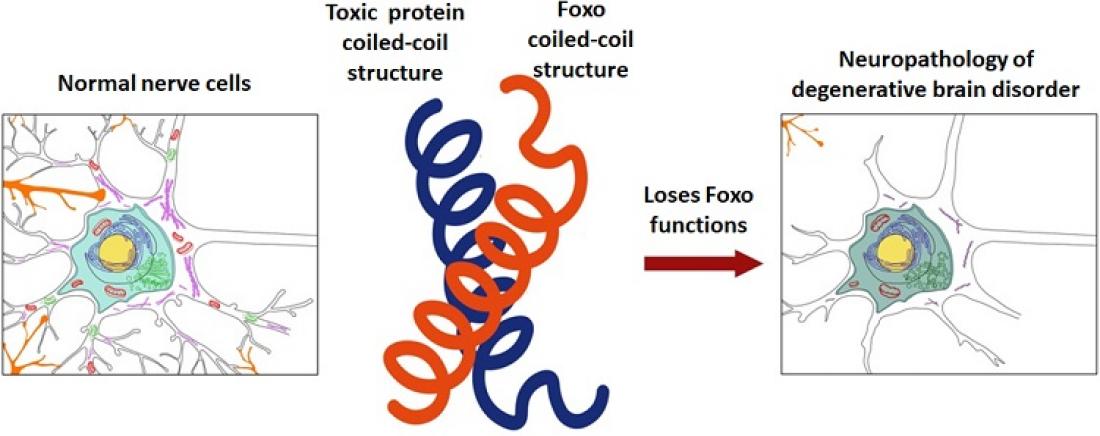Conceptual Diagram on the Entanglement of Toxic Protein and Foxo Protein Coiled-coil Structure - In a nerve cell, the coiled-coil structure of polyglutamine toxic protein is entangled with Foxo protein, a transcription factor. Here, the Foxo protein loses its normal functions and early neuropathology of degenerative brain disorder such as dendrite loss appears.
A research team led by Professor Sung Bae Lee of Brain and Cognitive Sciences and Professor Daehee Hwang of New Biology (Vice-head of the Plant Age and Life Research Group, IBS) has identified the early neuropathology mechanism of structural characteristics of polyglutamine toxic protein on neurodegenerative brain disorders. It was through a joint research with Professor Yuh Nung Jan at the Howards Hughes Medical Institute (HHMI) in the U.S. The number of patients with neurodegenerative disorders is growing rapidly as humans’ life expectancy is increasing. Although many scholars are devoted into researching the pathogenesis and the advancement of neurodegenerative brain disorders, not much has been identified yet. There is still too much work left to develop an actual treatment since it is difficult to diagnose the disease early. In this study, the researchers identified that coiled-coil structure of polyglutamine toxic protein, which is like an entangled telephone wire, causes the rapid deformation of neuron and early neurodegenerative diseases, such as Huntington’s chorea and spino-cerebellar ataxias. Proteins have abnormal combinations with each other to form the coiled-coil structure of polyglutamine toxic protein. The research team discovered that the coiled-coil structure of polyglutamine toxic protein inside neurons cause early neuropathy by combining with ‘Foxo protein’, which is adjusts the formation of dendrite, as a transcription factor. While the research focused on Foxo protein as the first factor of the early symptom of neurodegenerative brain disorders, it also predicted that other factors would exist. The research team thus expected to be able to speed the related studies in the future by focusing on clarifying additional factors based on this research. Professor Lee said “The core of this research is that the coiled-coil structure of toxin protein that causes degenerative brain disorders entangle with the coiled-coil structure of other protein, which is an important cause of early neurodegenerative diseases. By developing a treatment targeting the entanglement based on coiled-coil structure through this research, we expect to be able to have effective treatments to alleviate the early symptoms of neurodegenerative brain disorders” This study has been published on November 6th issue of international journal called Proceedings of the National Academy of Sciences with another commentary on ‘In This Issue’ section of the journal, as it was even selected by editors as a paper of highlight. The research was also recommended as an excellent paper on F 1,000 Prime (Faculty of 1,000 Prime), an excellent paper search system of the U.K. This research was also participated by Minjee Kwon and Myeonghoon Han of the Brain and Cognitive Sciences at DGIST as the first authors, who are both in the integrated master’s and doctoral program. For more information, contact: Sung Bae Lee, Associate Professor Department of Brain and Cognitive Sciences Daegu Gyeongbuk Institute of Science and Technology (DGIST) E-mail: [email protected]



